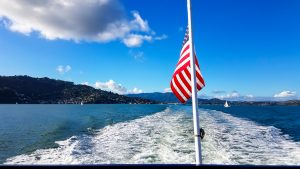
This the week of July 4th. For some, that means celebrating our nation’s independence with burgers, beer and boats. As alcohol is often mixed with boating, people are prosecuted and punished for boating under the influence (BUI). But how do law enforcement officers determine if a person’s ability to operate a boat is impaired by alcohol?
Standardized Sobriety Tests And Sea Legs
Law enforcement officers have historically investigated BUI using the same Standardized Field Sobriety Tests (SFSTs) as those used for DUI / OVI cases on land. Those tests include the Horizontal Gaze Nystagmus (HGN), the Walk And Turn (WAT) and the One Leg Stand (OLS) tests.
In 1990, the U.S. Coast Guard, in conjunction with the International Association of Chiefs of Police (IACP), conducted a study regarding the utility of the SFSTs in the marine environment. The report from the study concludes the use of the SFSTs is effective for making the correct arrest decision, and the accuracy of the tests is not degraded in the marine environment. The report was later criticized because it ignored the effect of ‘sea legs’ on test performance.
In 2009, the U.S. Coast Guard again studied sobriety testing in the marine environment, this time in conjunction with the National Association of State Boating Law Administrators (NASBLA). The objective of this study was to develop sobriety tests which could be administered in the seated position. The study was conducted by the Southern California Research Institute, the same research company which developed the SFSTs.
Seated Sobriety Assessments Address Sea Legs Situation
The law enforcement officers in the 2009 study administered four tests with the subjects seated. The four tests were: the Horzontal Gaze Nystagmus (HGN), the Finger To Nose (FTN), the Palm Pat (PP) and the Hand Coordination (HC) tests. Using those four tests, officers predicted whether each subject’s BAC was over or under .08%. The officers made correct predictions in 72% of the cases.
Following the 2009 study, the IACP created a training manual for the four sobriety tests. That manual is the marine equivalent of the National Highway Traffic Safety Association’s manual for DWI Detection and Standardized Field Sobriety Testing. Marine law enforcement officers are now trained to administer the battery of four sobriety tests in the NASBLA Seated Battery Transition Training Course.
As Effective As Rowing With One Oar
The battery of four seated sobriety tests has questionable probative value. The Palm Pat test was only 65% ‘accurate’, and the Hand Coordination test was only 59% ‘accurate’. Although the Finger To Nose test was the most ‘accurate’, with a correct prediction percentage of 67%, that test was considered too unreliable to include in the SFSTs developed by NHTSA.
In addition, the officers’ predictions about suspects’ BACs were confirmed with portable breath testers which are generally considered unreliable and not admissible in Ohio courts. So the reliability of the sobriety tests was measured using an instrument which is known to be unreliable. With the exception of the HGN test, there is no research data indicating these tests are reliable predictors of BAC levels. There is also no evidence these tests have any correlation with the ability to operate a boat. As a result, the tests are essentially worthless.
Don’t Make The Wrong People Walk The Plank
Just as people can drive responsibly after drinking alcohol, people can also drink and boat responsibly. Those who do so irresponsibly create a risk of danger to themselves and others. Therefore, we want law enforcement investigating suspicions of boating under the influence. Most of the tests used in the investigation, however, do not effectively predict boating ability or blood alcohol level. Using unreliable sobriety tests creates a danger of innocent boaters being prosecuted.
 Columbus OVI/DUI Attorney Blog
Columbus OVI/DUI Attorney Blog

